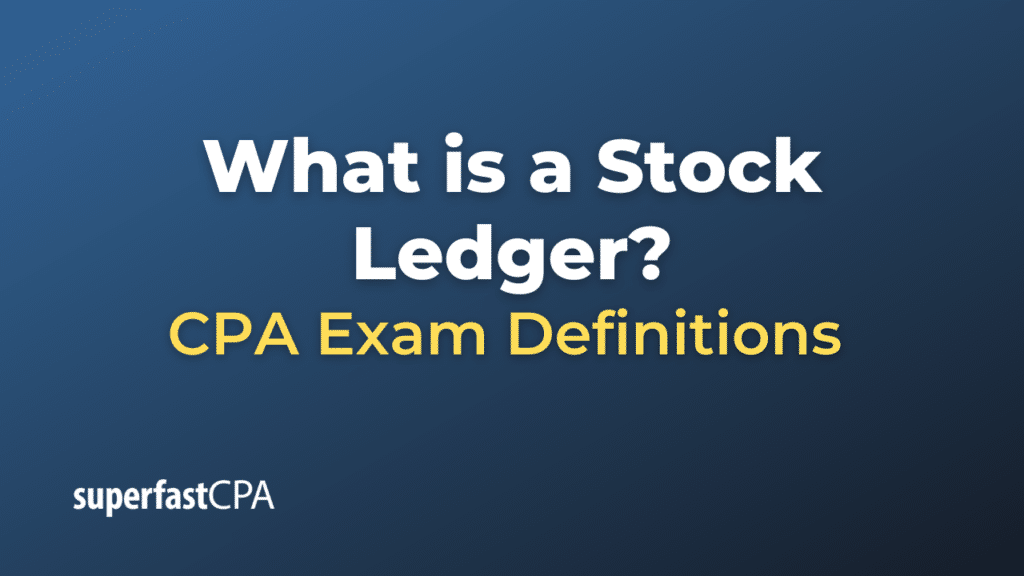Stock Ledger
A stock ledger, often referred to as a “share ledger” or “capital stock ledger,” is an official record maintained by a corporation that tracks the ownership of its stock. It details the transactions related to the company’s shares, including issuance, transfers, and repurchases. The stock ledger provides a historical account of each share, from its issuance to its current owner, ensuring transparency and accuracy in the company’s ownership records.
Key Components of a Stock Ledger:
- Shareholder’s Name: The full name of the individual or entity that owns the shares.
- Address: The address of the shareholder.
- Number of Shares: The quantity of shares held by the shareholder.
- Type of Shares: Specifies the class or type of shares (e.g., common stock, preferred stock).
- Certificate Number: If physical stock certificates are issued, each certificate will have a unique number.
- Issue Date: The date on which the shares were issued to the shareholder.
- Transfer Information: Details about the transfer of stock, including from whom it was transferred, to whom, the date of transfer, and any new certificate numbers if applicable.
- Cancellation Details: If shares are repurchased or redeemed by the company, these details are recorded, including the date and reason for cancellation.
Importance of a Stock Ledger:
- Verification of Ownership: The ledger confirms who the current shareholders of a company are and how many shares they own.
- Legal and Regulatory Compliance: Maintaining an accurate stock ledger is often a legal requirement to ensure transparency and accountability in stock transactions.
- Decision Making : Information about stock ownership is crucial during shareholder meetings, especially when votes are cast based on the number of shares held.
- Dividend Distribution : Dividends are paid to shareholders based on their share ownership. The stock ledger helps ensure the correct distribution of dividends.
- Corporate Actions: For actions such as stock splits or mergers, the stock ledger provides essential data about share distribution.
Example of a Stock Ledger
Let’s delve into a more detailed example to help illustrate the use and importance of a stock ledger:
Scenario: “GardenGrow Inc.”
“GardenGrow Inc.” is a startup company that specializes in urban gardening solutions. They’ve recently incorporated and issued shares to attract initial investors. They’ve decided to maintain a meticulous stock ledger to keep track of all share transactions.
Stock Ledger Entries:
Entry 1:
- Date: January 2, 2023
- Shareholder Name: Alice Johnson
- Address: 456 Plant Street, GreenCity, GC 12345
- Number of Shares: 5,000
- Type of Shares: Common Stock
- Certificate Number: GG-00001
- Issue Date: January 2, 2023
- Transfer Information: N/A (since it’s a new issuance)
- Remarks: Initial investor.
Entry 2:
- Date: February 15, 2023
- Shareholder Name: Bob Smith
- Address: 789 Sprout Lane, GreenCity, GC 12346
- Number of Shares: 3,000
- Type of Shares: Common Stock
- Certificate Number: GG-00002
- Issue Date: February 15, 2023
- Transfer Information: N/A (since it’s a new issuance)
- Remarks: Angel investor.
Entry 3:
- Date: March 10, 2023
- Former Shareholder Name: Alice Johnson
- New Shareholder Name: Charlie Green
- Address of New Shareholder: 123 Leafy Blvd, GreenCity, GC 12347
- Number of Shares Transferred: 2,000
- Type of Shares: Common Stock
- Old Certificate Number: GG-00001
- New Certificate Number: GG-00003
- Transfer Date: March 10, 2023
- Remarks: Alice sold a portion of her shares to Charlie.
Importance of the Stock Ledger in this Scenario:
- Ownership Tracking: “GardenGrow Inc.” can easily determine the number of shares each investor holds at any given time. This is crucial for decisions that require shareholder votes.
- Legal Protection: If any disputes arise regarding share ownership, the stock ledger provides an official record of all transactions.
- Financial Planning: By knowing who the shareholders are and their respective stakes, “GardenGrow Inc.” can plan dividend distributions, stock buybacks, or further share issuances.
In this example, the stock ledger offers a chronological and detailed record of share transactions for “GardenGrow Inc.”, ensuring clarity and transparency for all stakeholders involved.













